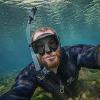Help with ID of Disease and Treatment Please
#21

Posted 06 December 2014 - 11:30 PM
News at 11...
Paul
#22

Posted 07 December 2014 - 03:29 PM
This particular treatment schedule calls for repeats at days 3, 7, 10, and 15. If the infestation is "bad" a day-5 treatment is recommended.
Paul
#23

Posted 21 December 2014 - 07:56 PM
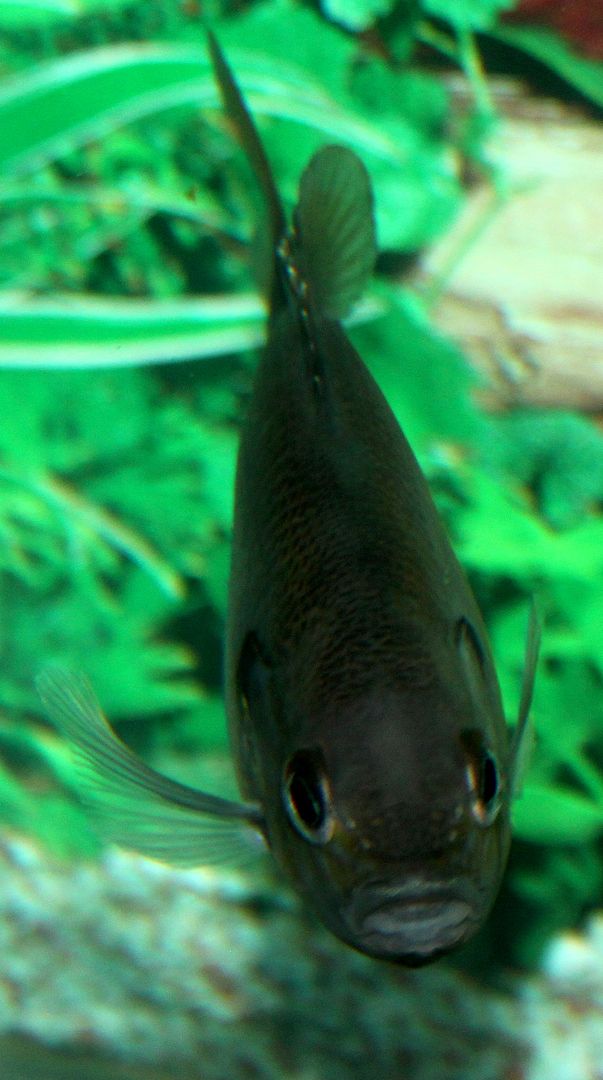
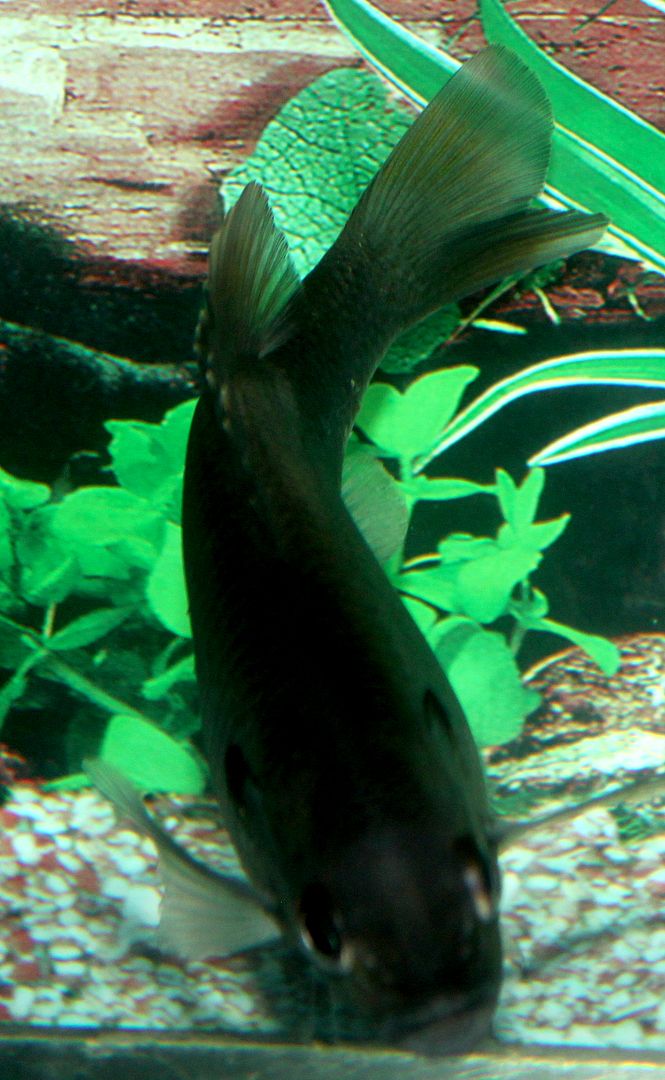
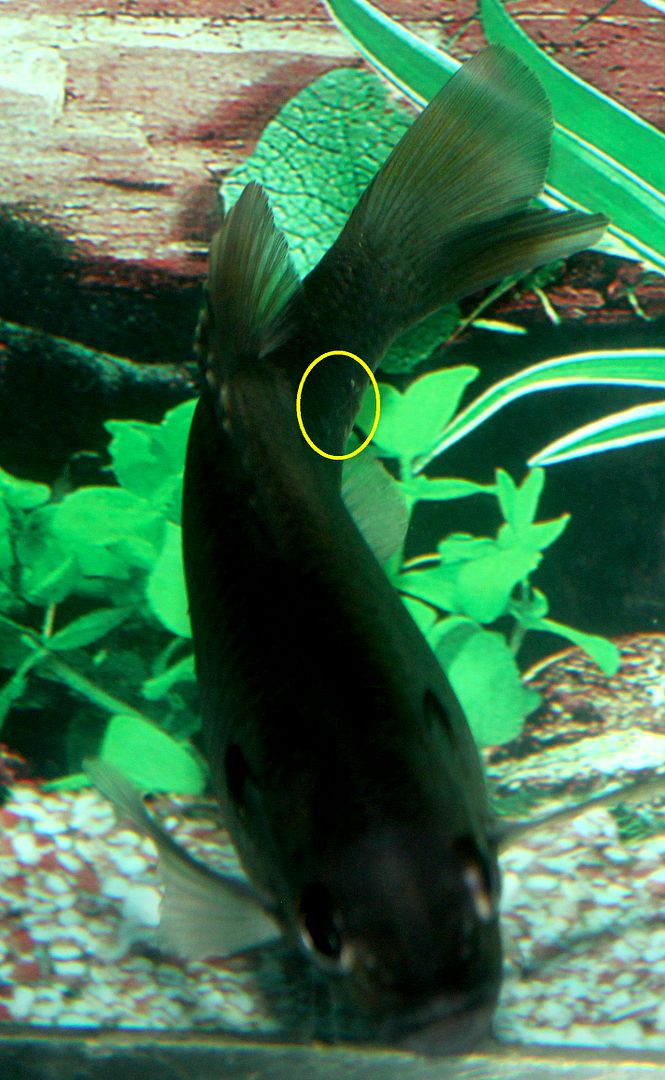
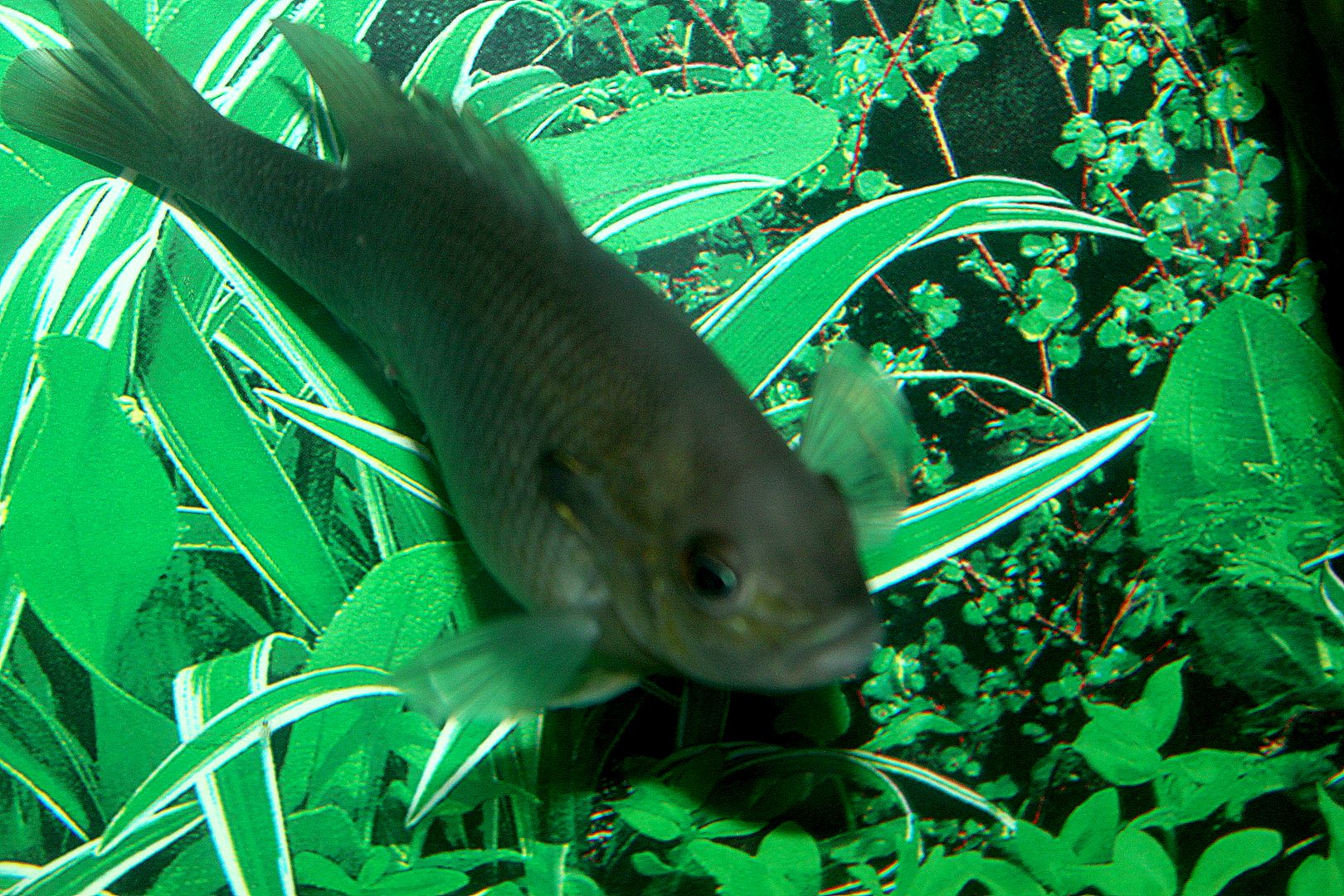
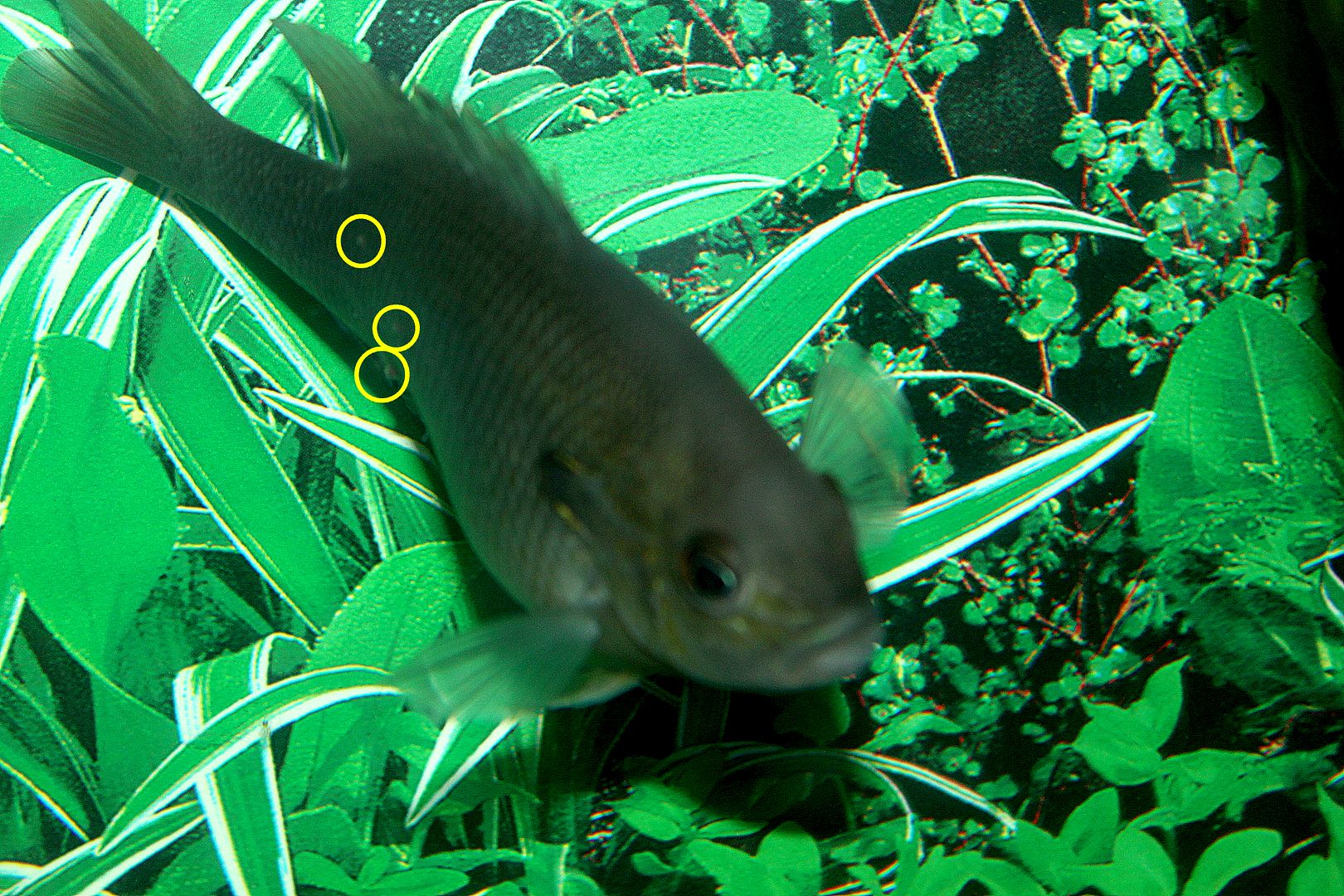



The ellipse on the caudal peduncle between the dorsal and caudal fins is to show that there are no lesions there. There were 4 before the treatment started.
On the subject of the ID of the species, does anyone think it could be, or at be a hybrid of a red-spotted? Remember that this fish is currently 18 months old at the oldest (brood year - 2013), and that it is probably a female. I'm unfamiliar with redspotted sunfish, so this is just a WAG, but if it's not a red-breasted, it's gotta be something.
I intend to continue the treatments until I see no 'lesions'. I suspect about another week should do it.
Thanks for the help!
Paul
#24

Posted 22 December 2014 - 07:44 AM
#25

Posted 22 December 2014 - 11:27 AM
The member formerly known as Skipjack
#26

Posted 22 December 2014 - 01:36 PM
#27

Posted 23 December 2014 - 01:53 PM
It also appears that every fish (of the centrarchids) I received is a female. How's that for 'odds'! I'm not sure what I'll do about that. I have a great deal invested in these fish, the most significant of which is time. While females are certainly as interesting behaviorally as males, there's really no comparison in 'looks'. I don't have unlimited aquarium space, and also don't care one whit about breeding fish, so I'm having a difficult time finding a rational justification for maintaining them. While I would hate to have the loss, these fish - except the bullhead - may have to go 'to the freezer', and I would just have to 'roll the dice' again. The fact that this fish is likely a hybrid further diminishes its value to me. I'l wait a little while longer to make that decision.
As to the "chunkieness" of this fish, not knowing exactly to what you are referring, centrarchid, I can't comment, but let me add that if it is its "belly" to which you refer, I keep these fish well fed, AND this fish is the most aggressive eater. Maybe a more correct description of the feeding behavior of the tank is that the other centrarchids are more reticent to feed. Here's the point I am trying to make: This fish isn't "aggressive" toward the other fish, it simply isn't hesitant to take food as soon as it appears. It does not harass the other fish, it simply "gets there" first. The others show no fear of this fish, even taking food items directly in front of it, but they simply 'hesitate' more before coming out to feed. Therefore, this fish almost always has a relatively distended belly. As does the bullhead. I actually have to change my mode of feeding due to the bullhead. If I simply "dump" the food - Tenebrio molitor, (larvae, pupae, and adults), blood worms, and Eisenia fetida - in the tank, most end up on the bottom before the centrarchids can consume them. That means the bullhead is likely to 'vacuum' the majority of them up. If instead I drop them in one or two at a time, the centrarchids take them before the catfish - relying solely on 'taste' instead of vision - can find them. At any rate, this centrarchid - redbreast, hybrid or whatever - is always "well-fed". If on the other hand, you are referring to the chunkiness of it's "shoulders" and other non-coelomic anatomy, then that indeed may be further indication of a species.
Thanks again, for the assistance with the treatment.
Paul
PS - One of the characteristics that "bothers" me about the ID of the fish being either a redbreast or red-spotted or any of the other similar "slab-sided" centrarchid are the green iridescent vermiculations on the rostrum and operculum. Those look VERY "green sunfishy" to me, and green sunfish are among the most 'promiscuous' of the sunfishes. My suspicion is a green x redbreast, maybe F2.
Paul
#28

Posted 23 December 2014 - 06:34 PM
http://jonahsaquariu...epauritus04.htm
Gerald Pottern
-----------------------
Hangin' on the Neuse
"Taxonomy is the diaper used to organize the mess of evolution into discrete packages" - M.Sandel
#29

Posted 23 December 2014 - 06:46 PM
#30

Posted 25 December 2014 - 07:05 PM
I'm only here on Christmas day to report a very strange and disturbing turn. New 'lesions' have turned up on the 'redbreast', and more significantly, both the pumpkinseed AND the bullhead now have lesions! All of a sudden 'things' have taken a turn for the worse, and just in the last three days!
The only element of these fish's life that has changed is that water temperature. I have infloor (radiant panel) heating in my house. Two weeks ago, the breaker tripped that controls the boiler. Because my house is so efficient, I didn't realize it for 7 days. When I reset the breaker, the temperature rose over the next few days to 80 F and remained there for several days. (I turned all of the thermostats off, but again, the house is so efficient, it takes DAYS to drop a degree or two.) Today, the temperature in the tank is 79 F. Other than that, there has been NO change in the fish's environment. (By the time I realized the boiler was off, the temperature in the tank had dropped to right about 70 F even.) I'm having a difficult time believing that the temperatures in question - 70 to 80 F - OR the time-frame over which the change occurred - about 10 days - could have caused sufficient stress to induce this problem, but I don't have any other ideas.
Do you?
Paul
PS - No problems in my other tanks.
#31

Posted 25 December 2014 - 08:22 PM
#32

Posted 26 December 2014 - 11:47 AM
Gerald Pottern
-----------------------
Hangin' on the Neuse
"Taxonomy is the diaper used to organize the mess of evolution into discrete packages" - M.Sandel
#33

Posted 26 December 2014 - 01:29 PM
The fins of the redbreast have not been affected through out this infection, but the fins of the pumpkinseed are now seriously affected, and in a very short interval of time. The catfish has two 'spots' - one on the tip of the right pectoral fin, and one at the ventral base of the caudal. I have to look closely to see the one on the pectoral fin. I'm actually quite concerned about the pumpkinseed. It has gone from "nothing" to "serious" in certainly no more than 36 hours.
The tank in question is subject to the (photo--periods) that one would find in a living room at the 63rd parallel. However, the tank lights are never on unless I turn them on briefly (a minute or less) to have a detailed look around the tank. Such a 'look around' rarely happens more frequently than once every other day or so. The closest room light to the tank is approximately 15 feet away. This time of year, there is insufficient light - from any source - to sustain any algal growth in the tank. On the other hand, ambient light in the summer 'encourages' a very healthy algal crop.
I'd be surprised if light had anything to do with this change, but then there aren't too many elements to consider and light is certainly a main one. I'll do a chemistry test and see if there are any indicators there. If the chemistry tests don't reveal any obvious cause, I will do a 'scrape' of each of the 'lesions'. I didn't do that to the redbreast because I didn't want to stress it. The pumpkinseed is looking pretty ragged, and I really don't want to add to what is certainly a sudden stressor, but I will if I think it is necessary.
Paul
#34

Posted 26 December 2014 - 03:56 PM
Go tonight without disturbing fish after dark and look at them with a red light.
#35

Posted 26 December 2014 - 08:16 PM
Paul
PS - Oh yeah; No chemistry issues linked to pH, (7.4-7.6), nitrites (0), nitrates (0), or ammonia (0).
Paul
#36

Posted 27 December 2014 - 09:12 AM
#37

Posted 09 January 2015 - 01:25 PM
I believe the problem was living on the upper edge of the temperature range at ~72 degrees Fahrenheit then spiking up to ~80 degrees for several days. When the temperature went up, it was all it took to 'tip them over the edge'. I have seen this many times in cold-water fish. While these are clearly not cold-water fish, most centrarchids can find, (except in the smallest impoundments), refugia cooler than 80 to 82 degrees Fahrenheit. I think the extra heat was just too much. This belief is supported by the observation that the fish are now "all right" after the temperature dropped back to ~72 degrees F. Still too hot for my preferences, but no solution in the immediate future. I am planning to build a cooling unit, but too many other irons in the fire at the moment.
The treatment has proven successful but based on the above issue, I have my doubts that the 'pathogen' has been removed from the tank. I really don't like the idea of sterilizing the tank. Possibly cooler water will prevent that drastic a measure. My intent is to keep them at an annual temperature cycle consistent with a 'natural' body of water at about 45 degrees north latitude. That too will likely help keep stress-related infections at bay. Finally, I am looking for a controller for ambient light that I can program. My intent is to simulate the diurnal ambient light also at about 45 degrees north latitude. Do any of you know of such a controller 'on the market'. I hate reinventing the wheel or paying "government" prices for things.
Thanks again for your help,
Paul
#38

Posted 10 January 2015 - 08:54 AM
#39

Posted 10 January 2015 - 10:36 PM
Paul
#40

Posted 11 January 2015 - 01:14 AM
0 user(s) are reading this topic
0 members, 0 guests, 0 anonymous users


